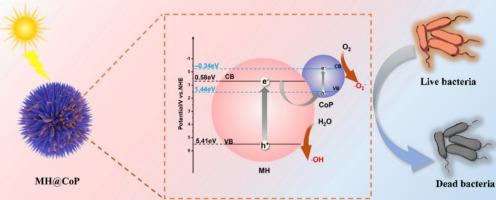纳米片嵌入类海胆MH@CoP z型异质结的可控制备,增强了物理和光催化协同抗菌性能
IF 6.9
2区 材料科学
Q2 CHEMISTRY, PHYSICAL
引用次数: 0
摘要
通过水热和磷酸化工艺制备了一种新型的嵌入纳米片的海胆样MH@CoP z型异质结,用于抗菌方法。MH@CoP具有优异的广谱抗菌活性,通过物理/机械穿刺和光催化抑菌过程协同作用,在可见光照射下对金黄色葡萄球菌(S. aureus)、大肠杆菌(E. coli)和耐甲氧西林金黄色葡萄球菌(MRSA)的抑菌效率均在90%以上。MH@CoP纳米片嵌入的海胆状结构提供了独特的Mg-Co异质结界面,有利于通过z型电荷-载流子转移诱导光生载流子的快速分离和流动,从而提高电荷分离效率。因此,这种改进有助于在可见光激发下产生大量活性氧(ROS),通过氧化对细菌进行灭菌。此外,MH@CoP向外的尖刺为细菌细胞膜提供了互补的机械刺穿。证实了MH@CoP纳米片的协同抑菌机制,特别是其所含的带正电的氢氧化镁纳米片能够快速捕获细菌,并在可见光照射下通过刺穿和ROS氧化损伤将被吸附的细菌就地消灭。优异的抗菌性能加上优异的可重复使用性和低细胞毒性,使MH@CoP成为抗菌感染和种植体消毒的良好候选者。本文章由计算机程序翻译,如有差异,请以英文原文为准。


Controllable fabrication of nanosheet-inserted urchin-like MH@CoP Z-scheme heterojunction for enhanced physical and photocatalytic synergistic antibacterial performance
A novel nanosheet-inserted urchin-like MH@CoP Z-scheme heterojunction is prepared via hydrothermal and phosphorylation processes, for the antibacterial approach. The MH@CoP exhibits excellent broad-spectrum antibacterial activity, through synergizing the physical/mechanical piercing and the photocatalytic antimicrobial process, and the antibacterial efficiency against Staphylococcus aureus (S. aureus), Escherichia coli (E. coli) and Methicillin-resistant Staphylococcus aureus (MRSA) under visible-light irradiation are all over 90%. The nanosheet-inserted urchin-like structure of MH@CoP provides a unique Mg-Co heterojunction interface, favorable inducing the rapid separation and flow of photogenerated carriers through Z-type charge-carrier transfer, thus improving the charge separation efficiency. Consequently, this improvement facilitates the generation of massive reactive oxygen species (ROS) under visible-light excitation, that sterilize bacteria through oxidation. Besides, the outward-facing spikes of MH@CoP provide complementary mechanical piercing of bacterial cell membranes. The synergistic antibacterial mechanisms are confirmed that the MH@CoP, especial the positively charged magnesium hydroxide nanosheets in it, capture bacteria rapidly and the adsorbed bacteria are then in-situ eliminated through piercing and ROS oxidative damage under visible illumination. The excellent antibacterial performance plus the superior reusability and low cytotoxicity, make MH@CoP a good candidate for antimicrobial infection and implant disinfection.
求助全文
通过发布文献求助,成功后即可免费获取论文全文。
去求助
来源期刊

Applied Surface Science
工程技术-材料科学:膜
CiteScore
12.50
自引率
7.50%
发文量
3393
审稿时长
67 days
期刊介绍:
Applied Surface Science covers topics contributing to a better understanding of surfaces, interfaces, nanostructures and their applications. The journal is concerned with scientific research on the atomic and molecular level of material properties determined with specific surface analytical techniques and/or computational methods, as well as the processing of such structures.
 求助内容:
求助内容: 应助结果提醒方式:
应助结果提醒方式:


